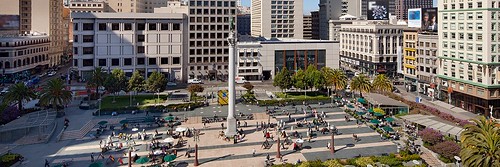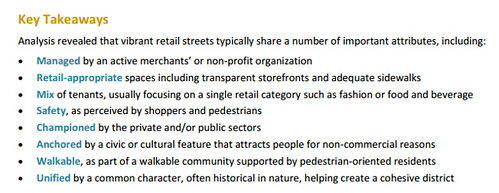Main Streets Around The World | 2017 Report from Cushman & Wakefield
In the US, the five retail districts experiencing the greatest growth in rents are in San Francisco (Union Square and Post Street), Chicago's East Oak Street, Downtown Seattle, and the Georgetown district of DC, according to the annual report Main Streets Around the World by Cushman & Wakefield, a leading commercial real estate broker active globally.
In San Francisco, Macy's is consolidating their Union Square properties a block off the square ("Is your local Macy's closing? Department store lays out real estate plans," MarketWatch).

Union Square, San Francisco.
Spatially, I've always thought that it would be possible to create a kind of Union Square effect around Farragut Square in Washington, which is between 17th, 18th, K and I Streets in Washington. It's served by two Metrorail stations, Farragut West and Farragut North, but it isn't as big as its counterpart in SF, and the buildings aren't easily reconfigured into department stores, plus Macy's big store investment in the city's Central Business District is at Metro Center.
For DC, I don't think the report adequately distinguishes between retail and restaurants. There is a lot of activity, even creativity, in the restaurant side of "retail" and commercial district development."
But I don't feel that's the case for retail. Most commercial districts are weak in categories outside of convenience retail--groceries, pharmacy, hardware. And there isn't a profusion of creative retail outlets.
There are many reasons for this.
(1) DC is still relatively small population-wise
(2) and has too much retail space that needs to be filled vis-a-vis demand
(3) and the phenomenon of what I call "intra-city sprawl" where new areas are being developed (The Wharf, CityCenter, Capitol Riverfront/Navy Yard, etc.) while other areas still languish
(4) plus rents are too high based on the revenue capacity of building footprints (see "Clevelad Park retail: my off hand assessment is that the rents are too high," 2009).
This has to do with how the commercial property market is shaped by the international market of Downtown real estate and how this creeps out and shapes submarkets across the city, even those that are decidedly local in their customer base, sales potential, and property ownership ("Avoiding the real problem with DC's property tax assessment methodologies," 2007).
(5) the way to address this is twofold; in terms of rents, DC could develop an initiative like that of SEMAEST, a community development corporation in Paris which has been charged with buying/leasing/holding prime retail properties and renting them to quality tenants at below market rates.
According to NextParis ("Opération Vital'Quartier: pour le commerce de proximité à Paris!") so far the initiative has supported 372 businesses in more than 500,000 s.f. of space.
(6) the other is the creation of an initiative to support the development of retail concepts and businesses as opposed to restaurants. DC helped to fund a "Vibrant Streets Toolkit" produced by the StreetSense retail consultancy, but it doesn't seem to have had much effect on the "retail" aspect of DC's commercial district, although there are some exceptions where apparel, book stores, and other concepts exist here and there in retail districts across the city.
DC Vibrant Retail Streets Toolkit. They've since gone on to develop the approach more broadly, and have produced a book on the subject, marketed on a separate Vibrant Streets website.

Another is the development of the Second Street district in Austin, Texas where the city and the developer, wanting to create retail in concert with Austin's independent vibe ("Keep Austin Weird") made developing independent businesses the priority for a district that will eventually have 200,000 square feet of shops, restaurants, and other retail services.
In 2005, when I first wrote about it, they focused on clothing and housewares and furniture stores, but with a wider range including a scooter store and a day spa. The lease provisions included build out allowances, a graduated rent schedule so that precious working capital at the opening of a store could be spent on inventory, and the retailers contribute funds to a joint marketing program.
These days of course there are plenty of restaurants, galleries, and also well known design forward retailers like Design Within Reach (see "Another point about urban retail," 2012).
Various articles over the years in the Austin American-Statesman describe the Second Street District effort. If you have a local library card and access the newspaper database, the articles are available to you.
Another example is the creation of "market spaces" as a kind of independent retail incubator. One example is Building Character in Lancaster, Pennsylvania, or the Midtown Exchange in Minneapolis and the Mercado in Portland, Oregon. Of course, public markets and food halls are the most well known example of this type. Such spaces address the issue of access to space and concentration and focusing of a customer base.
(7) it's key how the Austin effort included joint marketing. That's a major weakness for the various DC commercial districts. Although it can be hard to market "retail" when there is very little of it (see "Why it's hard to (holiday) shop in DC's neighborhood retail districts," 2011).
Labels: commercial district revitalization planning, cooperative-community retail, formula retail, retail planning




5 Comments:
I'm a bit shocked that Georgetown is on that list. I didn't think there has been much change in the last year. The big thing was removal of the liquor restriction, and maybe they are measuring restaurants.
Not sure if you've seen this:
http://www.eater.com/2016/3/18/11262706/eataly-theme-park
Nope. Thanks. I'd heard about this project, but haven't read about it. Not sure I'd want to try to open one in the US, but obviously on a much smaller scale, food halls and other ventures are doing a bit of this.
good luck trying to get our incredibly calcified moribund business as usual DC government to implement or even to listen to any of these ideas which you have Richard- and they certainly need to be listened to.
a collective store in Virginia Beach, where three people combine there separate businesses, which remain separate, but in one space:
https://pilotonline.com/news/local/article_74d91f7c-46fe-11e8-8c11-538a032e2d04.html
5/11/2018
and in Baltimore, a similar kind of effort, but as a pop up:
https://baltimorefishbowl.com/stories/local-women-open-new-shop-homegrown-baltimore-in-harbor-east/
Post a Comment
<< Home